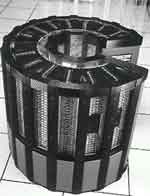The reanimators
 one person's trash can become ano-ther's treasure. Two researchers in Tennessee, usa, have once again proved this universal truth. They have put together a serviceable supercomputer by combining several dozen old personal computers (pcs) containing the now-ancient Intel 486 processor - machines that the current generation of home computers would turn their electronic noses up at (New Scientist , Vol 157, No 2117).
one person's trash can become ano-ther's treasure. Two researchers in Tennessee, usa, have once again proved this universal truth. They have put together a serviceable supercomputer by combining several dozen old personal computers (pcs) containing the now-ancient Intel 486 processor - machines that the current generation of home computers would turn their electronic noses up at (New Scientist , Vol 157, No 2117).
Two years ago, computer scientist Forrest Hoffman and landscape eco-logist Will Hargrove from the environmental science department of Oak Ridge National Laboratory (ornl), usa , asked the laboratory's managers for funding to buy 16 state-of-art Pentium pcs to build a "Beewolf" supercomputer.A Beewolf consists of multiple pcs linked together, and attacks compli-cated calculations by dividing them up and delegating these more manageable tasks to the smaller processors.
ornl management turned down the researchers' request. "We got really frustrated," says Hoffman. "But we weren't going to give up." At the laboratory's "swap shop" and by pestering their colleagues, they scavenged the needed networking equipment and a motley collection of 486 pcs, which are now regarded as obsolete.
In an empty lab, and during their spare time, Hoffman and Hargrove assembled the Stone Souper computer. The name comes from the Stone Soup fable, in which a hungry soldier claims he will make soup from a stone, then convinces people to donate enough "extra" ingredients to make a real soup.
Eight months later, the Stone Souper has grown into a sprawling collection of 56 linked computers and can perform an astounding 1.5 billion floating-point operations per second. Though this might not be enough for truly gigantic computational tasks, such as modelling the flow of electromagnetic radiation in space, but it is more than adequate for Hargrove's project: showing how conditions for plant growth vary across us on maps with a resolution of one square kilometre.
In a month or two, when the researchers would have expanded their Stone Souper to their goal of 64 pcs, the machine will be able to incorporate 10 variables influencing plant growth, including rainfall, temperature and soil chemistry.
"In terms of raw power, it's not the most macho thing," says John Cobb, a computer specialist at the ornl. But since its components were essentially free, he adds that the Stone Souper may set a new record for another popular computer benchmark: the price-to-performance ratio.
Hoffman also plans to "soup up" the Stone Souper , when people start throwing their current pcs. "Within the next year or so, we think we'll start getting Pentiums donated," he says hopefully.
In another unrelated-but-pertinent development, Livingstone Rental, a London-based company releasing pcs to businesses across Europe, announced that new personal computers are becoming obsolete faster with each passing year. If the trend continues, a pc purchased as we celebrate the millen-nium could be good for just six months' use. Though this might be good news for Hoffman and Hargrove, the rest of the scientific community is not exactly overjoyed.
Livingstone monitors the speed at which rented equipment is returned by its customers who want a newer model. This trend is inexorable, with the useful life of a pc used in business falling by two to three months annually. Three years ago, when pcs with Intel 486 chips basking in their top-of-the-line status, their rental life was around 17 months. Machines based around the early Pentium chips running at 133 megahertz (mhz), which dominated the markets in 1996, lasted a little over 14 months. In 1997, pcs with 166- mhz Pentium chips were returned after only 11 months and had been replaced by Pentiums running at 120- mhz. The newest pcs run at 300 mhz. Livingstone's data show that the lag between a new machine being introduced and the peak demand for rentals is also decreasing.
